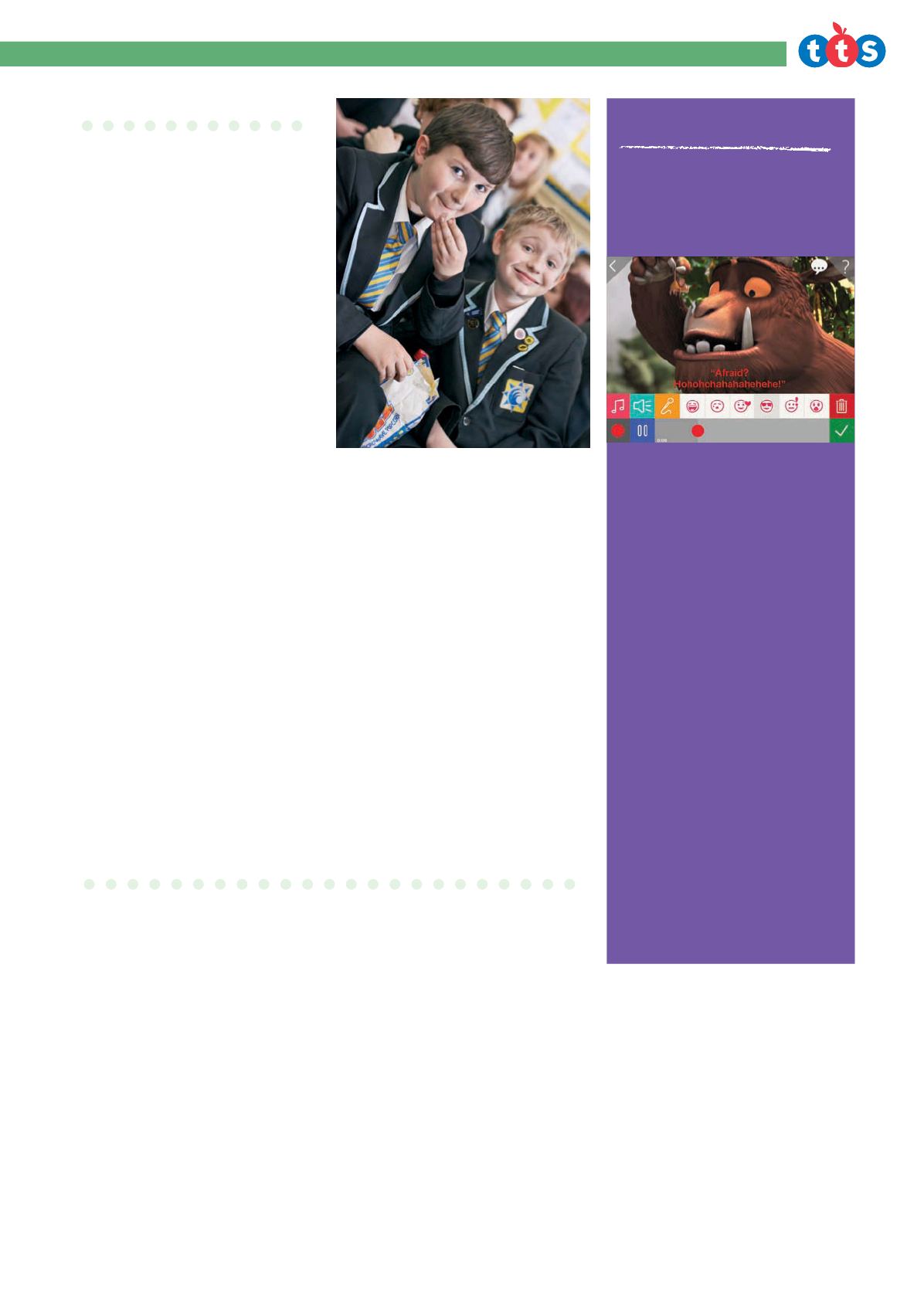
TEACH READING & WRITING
43
INTOACTION
INTO FILMOFFERS AWEALTHOF
FREE RESOURCES FOR PRIMARY
LITERACY – HERE ARE FIVE THAT
WOULDMAKE A GREAT STARTING
POINT FOR EXPLORATION:
∆Storymaker: TheGruffalo Edition
(cross curricular activities and
technical advice to support Into Film
Storymaker: TheGruffalo Edition app,
available fromTheApp Store)
intofilm.org/resources/133
∆Book to Film (explores popular book
adaptations onfilm)
intofilm.org/resources/278
∆Creating Effective
FilmReviews: Primary
intofilm.org/resources/108
∆RoaldDahl on Film
intofilm.org/resources/116
∆Communication Symbols for Film
Reviewing (for use in a SEN/ASN
Setting)
intofilm.org/resources/225
Into Film (intofilm.org) is aUK-wide
education organisationwhich puts
filmat the heart of young people’s
learning and personal development.
For further training, resources
and activities, book a free ‘Raising
LiteracyAttainment Through Film’
session for teachers at your school
at intofilm.org/training
1
Choose one ormore short (maximumtwo
minutes) sequences fromafilm, featuring
a selection of characters youwish to focus on.
2
Beforewatching the clips provide learners
with simple outline drawing of the
characters – or create themtogether, perhaps
by getting pupils to lie down on large sheets
of paper and have their friends drawaround
themtomake life-sized silhouttes that can be
stuck to awall.
3
Divide pupils into groups, and assign one
character to each. Explain that youwill be
showing themfilmclips, and afterwards, you
would like themtowritewords describing
‘their’ character on thematching picture.
They should addwords describing how the
audience and other characters see them
outside the outline, andwords explaining how
they see themselves, within it (alternatively,
youmay prefer to ask thewhole class to
focus on one character at a time and then
compare and contrast them).
4
Ask groups to bring their annotated
character outlines together, adding
speech and thought bubbles to demonstrate
how these characters interact – this can
consolidatewhat pupils have seen in thefilm
or support prediction.
5
The annotated character outlines can
then be displayed in the classroomand
serve as a aide-memoir for writing and
drama activities. For example:
∆
A chat showor press conference
with the characters.
∆
Creation of a character wordle, acrostic,
poemor set of trading cards.
∆
Creation of aflash forward storyboard to
planwhat the characters do after thefilmhas
ended. This can be developed into a simple
filmand/or a piece of writing.
This activitywill help learners to visualise
characters they read andwrite about, and
develop an understanding of their ranges
of thoughts, feelings andmotivations. It
supports pupils to consider and demonstrate
howauthors (including themselves) encode
information to tell the audience about a
character through their physical appearance,
thoughts, speech and actions, and that these
may change throughout a story.
ACTIVITYTWO
ROLEONTHE WALL
PUPILSWILL
∆
Deduce and infermeaning about
characters fromfilmtext
∆
Compare and contrast characters,
and consider the purpose of a text by
retrieving information fromafilmtext
∆
Demonstrate prediction and encoding
skills throughwriting and drama activities
1
Choose awritten piece of text that
describes a setting and features one or
more characters. Youmay choose a piece
of fiction, a poemor a description of an
historical event.
2
Ask pupils to close their eyes and
listen to you read it aloud. Then ask for
their initial ideas about what they ‘saw’ and
ACTIVITYTHREE
SHOEBOXSETDESIGN
PUPILSWILL
∆
Demonstrate and develop close listening
and reading skills to retrieve information
∆
Evaluate structure and discuss language
to decode awritten text
∆
Encodemeaning using all 3Cs and 3Ss
‘heard’ as youwere reading. Use the 3Cs
and 3S questions to lead discussion.
3
Now read the text againwith pupils,
providing themwith a copy.
4
Explain that pupils are going to create the
filmset for this scene, using a shoebox and
craftmaterials. Students should think about
all Cs and Ss and encode their set with the
meaning fromthewritten text. The set should
include characters and cameras that canmove
around (these can be created using card stuck
onto pencils or figures like Lego).
5
Once the set is complete ask learners
to take a series of photographs to
demonstratewhich shot would be used at each
point. To complete this learners can break
down thewritten text for themselves or you
can provide the text divided intofive or six
manageable sections.
6
The photographs can be printed out
with the text inserted underneath or
assembled in a storyboard using an app like
Comic Life.
7
Following this activity students could do
it ‘in reverse’, working froma set of film
stills, annotating themwith a description and
dialogue, and then developing ideas into a
piece of extendedwriting.
This activitywill help learners to visualise
the texts they read, using the skills they
have developed throughwatchingfilmtexts
to construct a rich piece of writing including
evidence of all the Cs and Ss.


